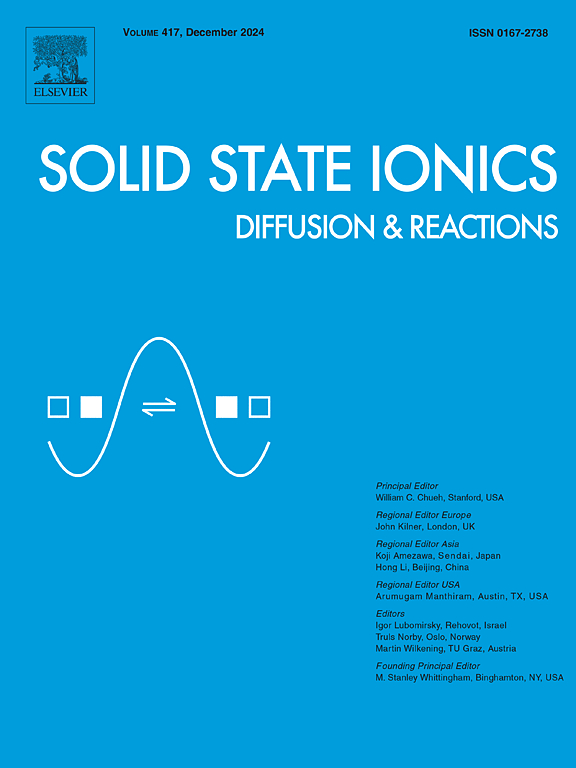氧化石墨烯增强海藻酸盐-聚乙烯醇生物聚合物电解质,具有改善的质子电导率和超级电容器应用的电化学稳定性
IF 3.3
4区 材料科学
Q3 CHEMISTRY, PHYSICAL
引用次数: 0
摘要
本研究探讨了氧化石墨烯(GO)掺入对掺杂硝酸铵(NH₄NO₃)的海藻酸盐-聚乙烯醇(PVA)聚合物电解质的结构和电化学性能的影响。FTIR分析揭示了氧化石墨烯(GO)与聚合物主体之间的特定分子相互作用,而XRD结果证实了复合材料的非晶态性质增强。当氧化石墨烯(GO)负载为2 wt.%时,该体系在室温下的离子电导率峰值为1.07 × 10−3 S cm−1,具有较高的离子转移数(t≈0.98)和2.85 V的扩展电化学稳定窗口。用这些电解质制成的对称超级电容器的比电容为240.78 F g−1,能量密度为131 Wh kg−1,长期循环稳定性高达10,000次循环。这些结果表明,氧化石墨烯诱导的结构调制显著提高了质子传输和电化学性能,为下一代储能设备提供了一个有前途的基于生物聚合物的平台。本文章由计算机程序翻译,如有差异,请以英文原文为准。

Graphene oxide-enhanced alginate-PVA biopolymer electrolytes with improved proton conductivity and electrochemical stability for supercapacitor applications
This study explores the effect of graphene oxide (GO) incorporation on the structural and electrochemical properties of alginate–poly(vinyl alcohol) (PVA) polymer electrolytes doped with ammonium nitrate (NH₄NO₃) for supercapacitor applications. FTIR analysis revealed specific molecular interactions between graphene oxide (GO) and the polymer host, while XRD results confirmed the enhanced amorphous nature of the composite. At 2 wt.% GO loading, the system exhibited peak ionic conductivity of 1.07 × 10−3 S cm−1 at room temperature, with a high ionic transference number (tₙ ≈ 0.98) and an extended electrochemical stability window of 2.85 V. Symmetric supercapacitors fabricated with these electrolytes achieved a specific capacitance of 240.78 F g−1, an energy density of 131 Wh kg−1, and long-term cycling stability up to 10,000 cycles. These results demonstrate that GO-induced structural modulation significantly enhances proton transport and electrochemical performance, offering a promising biopolymer-based platform for next-generation energy storage devices.
求助全文
通过发布文献求助,成功后即可免费获取论文全文。
去求助
来源期刊

Solid State Ionics
物理-物理:凝聚态物理
CiteScore
6.10
自引率
3.10%
发文量
152
审稿时长
58 days
期刊介绍:
This interdisciplinary journal is devoted to the physics, chemistry and materials science of diffusion, mass transport, and reactivity of solids. The major part of each issue is devoted to articles on:
(i) physics and chemistry of defects in solids;
(ii) reactions in and on solids, e.g. intercalation, corrosion, oxidation, sintering;
(iii) ion transport measurements, mechanisms and theory;
(iv) solid state electrochemistry;
(v) ionically-electronically mixed conducting solids.
Related technological applications are also included, provided their characteristics are interpreted in terms of the basic solid state properties.
Review papers and relevant symposium proceedings are welcome.
 求助内容:
求助内容: 应助结果提醒方式:
应助结果提醒方式:


